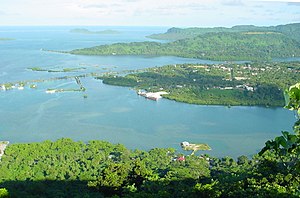Pohnpei
| Pohnpei (ponape) | ||
|---|---|---|
| View of the town of Kolonia | ||
| Waters | Pacific Ocean | |
| archipelago | Senjawin Islands , Caroline Islands | |
| Geographical location | 6 ° 51 ' N , 158 ° 13' E | |
|
|
||
| Number of islands | 25th | |
| Main island | Pohnpei | |
| length | 23 km | |
| Land area | 334.21 km² | |
| Lagoon area | 178.41 km² | |
| Highest elevation | Nanlaud 782 m |
|
| Residents | 36,196 | |
| Map of Pohnpei | ||
The island of Pohnpei (before November 8, 1984 Ponape , formerly Ascension Island ) is the main island of the Federal State of Pohnpei , part of the Federated States of Micronesia , to which another 162 smaller islands and atolls belong.
geography
The island of Pohnpei is one of the Senyavin Islands , which in turn the archipelago of the Caroline Islands in the western Pacific are. The land area including the minor islands is 334 km². The surrounding fringing reef includes a lagoon area of 178 km².
Pohnpei is the largest island of the Federated States of Micronesia and is divided into different landscapes: The coast consists mainly of mangrove forests, which are adjoined by grass-covered plains. The highlands are forested.
On Pohnpei lies Palikir , the new capital of the Federated States of Micronesia. The largest city, economic center and location of the island's airport is Kolonia , the capital of the state of Pohnpei.
In the mountains in the interior of Pohnpei, rainfall of up to 7600 mm per year was measured. The island is one of the rainiest places on earth.
history
Pohnpei was probably founded in the 1st millennium BC. Populated from Polynesia .
A highly developed culture existed on the island in pre-colonial times , the achievements of which are testified by the ruins of Nan Madol . The active period of this culture is scientifically disputed and is between the year 200 BC. And dated to the year 1200 AD.
Since the 16th century, Pohnpei was officially the east of the Spanish East Indies . With the German-Spanish Treaty of 1899 , the island became a German colony and the seat of the Ponape district . At that time, around 3,000 people lived in five "states": Not, Sokehs, U, Kiti and Metalanim. These areas were later also called districts and subdivided into sections . On October 18, 1910, the Sokehs uprising began and ended on February 22, 1911. On February 24th, some of the sokehs were executed after attending a church service and making confession. Part of the tribe was banished to other German South Sea islands and used there for forced labor . The exiles did not return to Ponape until the Japanese arrived.
In the First World War , when the war broke out from August 1 to 6, 1914, the two German armored cruisers SMS Scharnhorst and SMS Gneisenau were under the command of Vice Admiral Graf Spee in front of Ponape and disposed of their combustible materials there. The small cruiser SMS Nürnberg arrived from Honolulu . The island was later occupied by Japan . In the Pacific War during World War II, Pohnpei was not attacked directly by the US armed forces (" island hopping "). Often, however, Japanese positions were bombed or shot at.
After the war ended, Pohnpei became part of the US Pacific Islands Trust Territory .
On May 10, 1979, Pohnpei ratified the Constitution of the Federated States of Micronesia and became an integral part of this new nation with its official independence on November 3, 1986.
economy
The Pohnpeis economy is shaped by tourism . The cultivation of agricultural products for export also plays a certain role. Attempts are made to earn money with fishing rights for tuna.
Various bodies of the federal government are the largest employers.
Personalities
- Peter Christian (* 1947), politician
- Debra Daniel (* 1991), swimmer
literature
- Helmut Christmann: The uprising on Ponape (1910/11). Comments on German colonial policy in the South Seas ; in: Wilfried Wagner (Ed.): Structural change in the Pacific region. Lectures at the annual conference of the Pacific working group from 9. – 11. September 1987 in Bremen ; Bremen: Übersee-Museum Bremen, 1988; ISBN 3-88299-049-X ; Pp. 301-320.
- Georg Fritz : Ad majorem Dei gloriam! The history of the 1910/11 uprising in Ponape ; Leipzig: Dieterich, 1912. Digitized at UB JCS Frankfurt
- Thomas Morlang: Rebellion in the South Seas. The uprising in Ponape against the German colonial rulers 1910/1911 , Christoph Links Verlag, Berlin 2010, ISBN 978-3-86153-604-8 .
- Erich Kaiser: Contributions to the petrography and geology of the German South Sea Islands. In: Yearbook of the Royal Prussian Geological State Institute and Mining Academy in Berlin for 1903. Volume XXIV, Berlin 1907, pp. 110–112. pdf
Fiction
- Sibylle Knauss : The Missionary , Roman. Hoffmann and Campe, Berlin 1997, ISBN 3-455-03866-2 .
Web links
- Visitors Center
- A tour of Pohnpei
- Investors Guide to the State of Pohnpei ( Memento from October 26, 2012 in the Internet Archive )
- Carl Paul : The Mission in our Colonies. Part 4: The German South Sea Islands. Unolzen Verlag, Dresden-A. 1908. Pages 233-248.
- Pohnpei - Between Time & Tide Private Photo Collection
- Foreign Ships in Micronesia: Pohnpei , Discovery of and landings on Pohnpei 1528 to 1885, English






